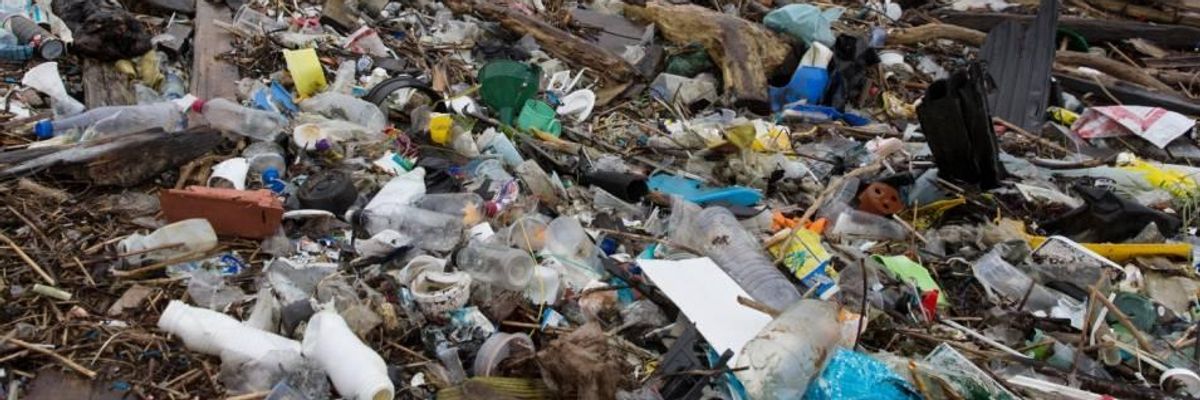
"Beautiful coral reefs succumb to plastic waste-borne bacteria depleting reef-supported fisheries." (Photo: Dan Kitwood/Getty Images)
Of Animals and Bees and Flowers Wild as Earth Day Nears
Serious concerns for anyone who cares for wildlife and the planet we inhabit.
Few people know that March 3 was World Wildlife Day, or this coming Sunday (April 22) is Earth Day -- perhaps Trump sucking up all the media oxygen is responsible. The fact remains, world wildlife is under serious threat, and in ways we can't even imagine -- not forgetting the eventual disaster due to climate change, unless the world wakes up.
Not too long ago Science, the voice of AAAS, America's largest science body, published three papers describing the harmful, even devastating, impact of modern human presence. These are encapsulated below, and should be of serious concern to anyone who cares for wildlife and the planet we inhabit.
Our plastic bag finally reaches the ocean and microbes hitch a ride on it, living longer and increasing their chances of landing on an unfortunate host: a coral reef. The authors have measured plastic items per 100 square meters. The count can vary from a low of 0.4 in Australia to a high of 25.6 in Indonesia. Size of human population in coastal regions, good management or mismanagement of plastic waste disposal are all factors in the amount of waste entering the water.
The study results are striking. The likelihood of disease from the microbes rises from 4 percent in areas free of plastic to a whopping 89 percent average when the corals have such debris. Another major issue is coral structural complexity which, importantly, underpins micro-habitats for reef-reliant organisms. Unfortunately, the study also finds that plastic debris is up to 8 times more likely to affect reefs with greater structural complexity. The resulting lack of habitat can devastate fisheries through a drop in productivity by a factor of three. Thus public awareness here could be a critical factor.
The scientists develop a human footprint index (HFI) comprising multiple aspects of human influence: built environment, croplands, pastures, nighttime lights, roads, waterways, railroads, population density, etc. On the animal side, they note and separate the effects of resource availability and body mass on vagility (migration distances) -- larger species travel further as do carnivores.
They then compute animal movement as the distance between subsequent GPS locations over nine time scales ranging from one hour to 10 days. At each time scale and for each individual, they calculate the median (middle range) and longest distance movements. These procedures point to the thoroughness of the research.
Overall the findings indicate a decline in movement of mammals in high HFI areas ranging on average from one-half to one-third of their movement levels in areas without human presence. For example, the median displacement of carnivores over the 10 day period in high HFI areas was only about half when compared to zero impact regions. And the long distance movement over the same period in HFI areas was down to a third, averaging 6.6 km versus 21.5 km. The impact on feeding and breeding then is clearly severe.
The authors note the consequences for ecosystem function globally as the effects are critical for wildlife conservation and also in the spread of disease. In the latter aspect, the authors warn that "reduced vagility may go beyond ecosystem functioning to directly affect human well-being." In their understated words, it means the danger of accelerated animal extinction and human epidemics.
The authors identify managed honeybees and their honey production and pollination of commercial crops as an agricultural issue, not an ecological one. They advocate restriction of managed honey beehives in protected-ecological areas to reduce their harmful effects noting that half of all European wild bees are threatened with extinction.
The engaging, lovable and cuddly koala is in danger from environmental effects. its unusual diet of eucalyptus leaves carry a toxin it can usually handle, but increased CO2 levels reduce nutrition and eating more leads to ingesting more poison. Add to this the Australian drought drying the leaves, leaving little moisture and resulting in kidney damage.
Altogether, these studies and cases convey a stark warning. They show that environmental degradation is the promise of a dismal future in which mammalian wildlife is scarce, wild pollinators and consequently wild flowers and plants are sparse, and beautiful coral reefs succumb to plastic waste-borne bacteria depleting reef-supported fisheries. This is our legacy unless we take a step back to reassess human wants for their impact on the environment.
An Urgent Message From Our Co-Founder
Dear Common Dreams reader, The U.S. is on a fast track to authoritarianism like nothing I've ever seen. Meanwhile, corporate news outlets are utterly capitulating to Trump, twisting their coverage to avoid drawing his ire while lining up to stuff cash in his pockets. That's why I believe that Common Dreams is doing the best and most consequential reporting that we've ever done. Our small but mighty team is a progressive reporting powerhouse, covering the news every day that the corporate media never will. Our mission has always been simple: To inform. To inspire. And to ignite change for the common good. Now here's the key piece that I want all our readers to understand: None of this would be possible without your financial support. That's not just some fundraising cliche. It's the absolute and literal truth. We don't accept corporate advertising and never will. We don't have a paywall because we don't think people should be blocked from critical news based on their ability to pay. Everything we do is funded by the donations of readers like you. Will you donate now to help power the nonprofit, independent reporting of Common Dreams? Thank you for being a vital member of our community. Together, we can keep independent journalism alive when it’s needed most. - Craig Brown, Co-founder |
Few people know that March 3 was World Wildlife Day, or this coming Sunday (April 22) is Earth Day -- perhaps Trump sucking up all the media oxygen is responsible. The fact remains, world wildlife is under serious threat, and in ways we can't even imagine -- not forgetting the eventual disaster due to climate change, unless the world wakes up.
Not too long ago Science, the voice of AAAS, America's largest science body, published three papers describing the harmful, even devastating, impact of modern human presence. These are encapsulated below, and should be of serious concern to anyone who cares for wildlife and the planet we inhabit.
Our plastic bag finally reaches the ocean and microbes hitch a ride on it, living longer and increasing their chances of landing on an unfortunate host: a coral reef. The authors have measured plastic items per 100 square meters. The count can vary from a low of 0.4 in Australia to a high of 25.6 in Indonesia. Size of human population in coastal regions, good management or mismanagement of plastic waste disposal are all factors in the amount of waste entering the water.
The study results are striking. The likelihood of disease from the microbes rises from 4 percent in areas free of plastic to a whopping 89 percent average when the corals have such debris. Another major issue is coral structural complexity which, importantly, underpins micro-habitats for reef-reliant organisms. Unfortunately, the study also finds that plastic debris is up to 8 times more likely to affect reefs with greater structural complexity. The resulting lack of habitat can devastate fisheries through a drop in productivity by a factor of three. Thus public awareness here could be a critical factor.
The scientists develop a human footprint index (HFI) comprising multiple aspects of human influence: built environment, croplands, pastures, nighttime lights, roads, waterways, railroads, population density, etc. On the animal side, they note and separate the effects of resource availability and body mass on vagility (migration distances) -- larger species travel further as do carnivores.
They then compute animal movement as the distance between subsequent GPS locations over nine time scales ranging from one hour to 10 days. At each time scale and for each individual, they calculate the median (middle range) and longest distance movements. These procedures point to the thoroughness of the research.
Overall the findings indicate a decline in movement of mammals in high HFI areas ranging on average from one-half to one-third of their movement levels in areas without human presence. For example, the median displacement of carnivores over the 10 day period in high HFI areas was only about half when compared to zero impact regions. And the long distance movement over the same period in HFI areas was down to a third, averaging 6.6 km versus 21.5 km. The impact on feeding and breeding then is clearly severe.
The authors note the consequences for ecosystem function globally as the effects are critical for wildlife conservation and also in the spread of disease. In the latter aspect, the authors warn that "reduced vagility may go beyond ecosystem functioning to directly affect human well-being." In their understated words, it means the danger of accelerated animal extinction and human epidemics.
The authors identify managed honeybees and their honey production and pollination of commercial crops as an agricultural issue, not an ecological one. They advocate restriction of managed honey beehives in protected-ecological areas to reduce their harmful effects noting that half of all European wild bees are threatened with extinction.
The engaging, lovable and cuddly koala is in danger from environmental effects. its unusual diet of eucalyptus leaves carry a toxin it can usually handle, but increased CO2 levels reduce nutrition and eating more leads to ingesting more poison. Add to this the Australian drought drying the leaves, leaving little moisture and resulting in kidney damage.
Altogether, these studies and cases convey a stark warning. They show that environmental degradation is the promise of a dismal future in which mammalian wildlife is scarce, wild pollinators and consequently wild flowers and plants are sparse, and beautiful coral reefs succumb to plastic waste-borne bacteria depleting reef-supported fisheries. This is our legacy unless we take a step back to reassess human wants for their impact on the environment.
Few people know that March 3 was World Wildlife Day, or this coming Sunday (April 22) is Earth Day -- perhaps Trump sucking up all the media oxygen is responsible. The fact remains, world wildlife is under serious threat, and in ways we can't even imagine -- not forgetting the eventual disaster due to climate change, unless the world wakes up.
Not too long ago Science, the voice of AAAS, America's largest science body, published three papers describing the harmful, even devastating, impact of modern human presence. These are encapsulated below, and should be of serious concern to anyone who cares for wildlife and the planet we inhabit.
Our plastic bag finally reaches the ocean and microbes hitch a ride on it, living longer and increasing their chances of landing on an unfortunate host: a coral reef. The authors have measured plastic items per 100 square meters. The count can vary from a low of 0.4 in Australia to a high of 25.6 in Indonesia. Size of human population in coastal regions, good management or mismanagement of plastic waste disposal are all factors in the amount of waste entering the water.
The study results are striking. The likelihood of disease from the microbes rises from 4 percent in areas free of plastic to a whopping 89 percent average when the corals have such debris. Another major issue is coral structural complexity which, importantly, underpins micro-habitats for reef-reliant organisms. Unfortunately, the study also finds that plastic debris is up to 8 times more likely to affect reefs with greater structural complexity. The resulting lack of habitat can devastate fisheries through a drop in productivity by a factor of three. Thus public awareness here could be a critical factor.
The scientists develop a human footprint index (HFI) comprising multiple aspects of human influence: built environment, croplands, pastures, nighttime lights, roads, waterways, railroads, population density, etc. On the animal side, they note and separate the effects of resource availability and body mass on vagility (migration distances) -- larger species travel further as do carnivores.
They then compute animal movement as the distance between subsequent GPS locations over nine time scales ranging from one hour to 10 days. At each time scale and for each individual, they calculate the median (middle range) and longest distance movements. These procedures point to the thoroughness of the research.
Overall the findings indicate a decline in movement of mammals in high HFI areas ranging on average from one-half to one-third of their movement levels in areas without human presence. For example, the median displacement of carnivores over the 10 day period in high HFI areas was only about half when compared to zero impact regions. And the long distance movement over the same period in HFI areas was down to a third, averaging 6.6 km versus 21.5 km. The impact on feeding and breeding then is clearly severe.
The authors note the consequences for ecosystem function globally as the effects are critical for wildlife conservation and also in the spread of disease. In the latter aspect, the authors warn that "reduced vagility may go beyond ecosystem functioning to directly affect human well-being." In their understated words, it means the danger of accelerated animal extinction and human epidemics.
The authors identify managed honeybees and their honey production and pollination of commercial crops as an agricultural issue, not an ecological one. They advocate restriction of managed honey beehives in protected-ecological areas to reduce their harmful effects noting that half of all European wild bees are threatened with extinction.
The engaging, lovable and cuddly koala is in danger from environmental effects. its unusual diet of eucalyptus leaves carry a toxin it can usually handle, but increased CO2 levels reduce nutrition and eating more leads to ingesting more poison. Add to this the Australian drought drying the leaves, leaving little moisture and resulting in kidney damage.
Altogether, these studies and cases convey a stark warning. They show that environmental degradation is the promise of a dismal future in which mammalian wildlife is scarce, wild pollinators and consequently wild flowers and plants are sparse, and beautiful coral reefs succumb to plastic waste-borne bacteria depleting reef-supported fisheries. This is our legacy unless we take a step back to reassess human wants for their impact on the environment.

